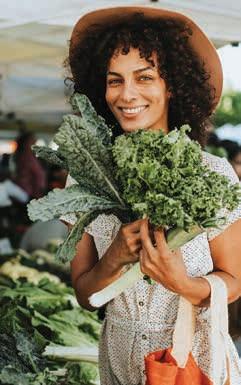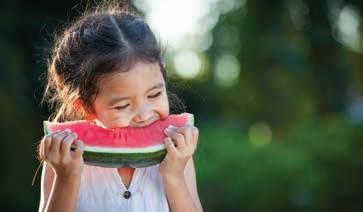
12 minute read
THE ROOTS OF
THE ROOTS OF GOOD HEALTH Thriving on a Plant-Based Diet

Advertisement

Whether identifying as vegan, vegetarian, pescatarian, fl exitarian or other veggie-friendly variant, a growing number of Americans are moving away from meat products and toward plant-rich foods. Most come to a plant-based diet for personal, planetary or animal welfare reasons; however, they stay for the fl avorful foods they discover along their dietary journey and the health benefi ts they reap. Marly McMillen-Beelman was prescribed medications to alleviate symptoms of irritable bowel syndrome. “I knew I didn’t want to be on prescriptions, so I decided to change my diet, beginning by giving up meat, dairy and eggs. I immediately felt much better and my symptoms went away naturally,” says the Kansas
by April Thompson
City, Missouri, author of Th e Everything Vegan Meal Prep Cookbook and founder of Chopped Academy, an online resource for food bloggers. “Now I eat an even greater variety of food than I did before I went vegan.” While only 3 percent of Americans identifi ed as vegan and 5 percent as vegetarian in a recent Gallup Poll, a 2018 report by restaurant consultants Baum + Whiteman indicates that about 83 percent are eating more plant-based foods. Embarking on a plant-based diet is a lifelong adventure, but it can take time to adjust. Experts recommend a healthy dose of self-love with the newfound fondness for fruits and veggies. “Give yourself some slack and realize that dietary changes do not happen overnight,” says
April Murray, a registered dietician in Costa Mesa, California. “Start with familiar plant-based foods you already enjoy, and ease into trying new foods, whether tempeh or lentils.” A plant-oriented diet also can be fl exible; health advocates encourage individuals to fi nd a diet that works for them and their families. Leah Webb, the Asheville, North Carolina, author of Simple and Delicious Recipes for Cooking with Whole Foods on a Restrictive Diet, has adapted her diet over time to accommodate her family’s health needs. Although Webb has always maintained a plant-rich diet, she began incorporating some animal products when her son was born. “He had severe food allergies and asthma, and needed a more diverse
diet,” explains Webb, whose daughter also has cystic fi brosis. Cutting out grains was a game-changer in “calming down his gut, where most of immune response lies,” says Webb. “He is now off asthma medication and the number of allergens he suff ers from has dropped from seven to two.” Webb’s family eats bountifully from their backyard garden, complemented by meat and produce from local farmers’ markets, where she can be certain the foods were produced sustainably and humanely. “I use meat to fl avor soups or accent vegetables, rather than as the star of the show. I like to focus on real fl avors, using lots of garlic, herbs and spices,” says Webb. Murray, author of Th e Everything Pegan Diet Cookbook: 300 Recipes for Starting—and Maintaining—the Pegan Diet, follows that diet, a mash-up of paleo and vegan regimens that focuses on whole, fresh and sustainable food high in healthy fats and vitamins. Th e Pegan diet eschews refi ned sugar and highly processed foods, while allowing meat, poultry, fi sh and eggs, as well as gluten-free grains, legumes and dairy products in small amounts. “Th is diet can be helpful to diff erent people in so many ways,” says Murray. “For people with diabetes and blood sugar dysregulation, this high-fi ber diet can
help lower blood sugar and insulin levels. Heart health will improve, as you’ll be eating less animal products, which can be high in cholesterol and saturated fat. Many individuals also fi nd themselves losing unwanted weight as they get fi lled up so quickly with these whole foods.”
Plant-Based Nutrition Made Easy While some worry about getting suffi cient nutrients on a largely plant-based diet, nutrition experts say these fears are unfounded. “People think they need to calculate every nutrient, but if you eat a plant-centered, whole-foods diet, you will get every vitamin and mineral you need to thrive,” says Ocean Robbins, co-founder of the Food Revolution Network and author of Th e 31-Day Food Revolution: Heal Your Body, Feel Great, and Transform Your World. Legumes, nuts and seeds are all healthy, abundant sources of protein and iron.
Navigating the lexicon of plant-based diets can be tricky, and choosing a diet even trickier. Here’s a brief guide to some of the commonly used terms. Flexitarians eat a mainly vegetarian diet, but will consume meat on occasion. Pegans (a term coined by Dr. Mark Hyman, who follows the diet) focus on eating vegetables, fruits, nuts, seeds, meat, fi sh and eggs, while avoiding dairy, grains, legumes, sugar and processed foods.
Pescatarians like radio host Howard Stern eat fi sh, seafood and other forms of animal products such as dairy, but don’t eat other forms of meat such as chicken, beef or pork. Plant-based diets, followed by celebrities like Ben Stiller, consist mostly or entirely of foods derived from plants, including vegetables, grains, nuts, seeds, legumes and fruits, with few or no animal products. Vegans don’t consume any animal products, including eggs, dairy, honey or gelatin. Famous vegans include Ellen DeGeneres, Betty White, Beyonce, Bill Clinton, Madonna and Venus Williams. Vegetarians refrain from meat and seafood, but will consume dairy or other animal byproducts such as honey. Well-known vegetarians include Albert Einstein, Arnold Schwarzenegger, Doris Day, Jane Goodall, Kristen Wiig and Prince. Plant-Based Primer
Reed Mangels, author of Your Complete Vegan Pregnancy: Your All-in-One Guide to a Healthy, Holistic, Plant-Based Pregnancy, busts the myth that cow’s milk is a must for growing bones. “Calcium, vitamin D and protein are the nutrients we usually associate with bone health. One easy way to get all three is a soy-based or pea protein-based plant milk that is fortifi ed with calcium and vitamin D,” says Mangels, adding that green vegetables like kale, bok choy, collards and broccoli are great sources of calcium. “‘Eating the rainbow’ is great way to make sure you’re consuming a variety of nutrients,” off ers London-based Ben Pook, who co-authored the cookbook So Vegan in 5 with his partner Roxy Pope. “Many vitamins, minerals and antioxidants bring their own distinctive colors to fruits and vegetables, so preparing colorful meals is a simple way of getting as many nutrients into your diet as possible.”
Getting Social Dietary changes can be challenging to navigate initially, particularly when faced with social situations ranging from family gatherings to cohabitation. Having a good plan going into such situations can help ease the transition, say experts. “Never show up to an event hungry. You will be more likely to make a good decision if you

are nourished. On the way there, remind yourself why you are making the transition to plant-based eating,” suggests Murray.
“I call myself a secular vegan because I don’t have a dogmatic approach to the way I eat. If I go to a family dinner and someone has made something special for me, but they used a non-vegan cheese, I will respect my family member’s effort and eat some of it. These situations will pop up from time to time, and the more you can be compassionate with yourself, the better,” says McMillen-Beelman.
“If you are living with people who are not joining you in making a dietary shift, agree to respect each other’s choices. Make it a shared learning journey rather than a power struggle,” says Robbins. For example, he suggests making a vegetarian base and allowing those that want animal products to add them as toppings. A burrito bar can accommodate all diets by allowing people to add their own fixings to a base of beans and tortillas, whether those be dairy options like cheese and sour cream or veganfriendly guacamole and salsa.
For families with kids, being flexible and inclusive can help make changes feel more positive and sustainable. “We never eat processed foods at home, but parties are that time I tell my kids they can eat
whatever they want,” says Webb.
“Get your children involved, so that they are more engaged in the eating experience. Let your children pick out recipes or snacks for the week. Make the food look pretty and it will taste more satisfying,” adds Murray.
Plant Prep Made Easy Plant-based chefs have plenty of kitchen hacks for making food prep and planning fun and easy. Robbins suggests finding go-to recipes to put on repeat. “Your prep time goes down a lot as you make the same dish, and the familiarity will help you develop lasting habits around new food patterns,” he says. Webb incorporates a healthy protein, fat and vegetable into every meal, even breakfast, but cooks in batches and freezes portions or repurposes leftovers to simplify mealtimes. “You’ll get burned out if you try to cook something from scratch every meal,” says Webb. “We eat a lot of eggs because we raise chickens, so I’ll do baked frittatas I can reheat during the week.” Advance meal prep can take the pressure off busy times like the weekday breakfast rush, adds Robbins. One of his favorite breakfasts involves soaking oats and chia seeds overnight, which he tops in the morning with some unsweetened soy or coconut milk, chopped banana, frozen blueberries, and a dash of maple syrup, vanilla and nutmeg. “It’s full of omega-3 fatty acids, protein, antioxidants and phytonutrients,” he says.
Webb encourages people to get out of their food comfort zones by experimenting with approximate ingredients, like swapping kabocha or honeynut squash for butternut squash.
Robbins also suggests making social connections with others on the same path by cooking them a meal, organizing a meal swap or sharing extras. “It’s not a diet or a fad; it’s a way of life. Start where you are and remember it’s not about perfection, it’s about progress. Have love, dignity and compassion toward yourself and others along the journey,” he says.
April Thompson is a freelance writer based in Washington, D.C. Connect at AprilWrites.com.
Many new regimens begin with gusto, only to be abandoned because old diets die hard. Here are some expert tips for eating well over the long haul.
“Find plant-based options at your favorite restaurants, and be open to new flavors. I promise you, your taste buds will change,” says April Murray, dietician and author of The Everything Pegan Diet Cookbook. To keep the momentum and inspiration going, follow plant-based chefs on social media, she adds.
When switching to a plant-based diet, some miss the rich, fatty flavors found in meat, says Ben Pook, co-author of So Vegan in 5. “The trick we found is using ingredients rich in umami, which is a flavor commonly found in meat. One of our favorites is miso paste (fermented soybeans), which has an intense savory taste. We often add it to stews, pies and even pastas to deliver more depth of flavor. Soy sauce and porcini mushrooms are also a great substitute.”
“Sustainable change doesn’t happen overnight. If not sure what to cook, start with one big salad a week. When you get the hang of that, add in something else, like prepping snacks from scratch. Small things add up over time,” says Leah Webb, author of The Grain-Free, Sugar-Free, Dairy-Free Family Cookbook.
“Seek out loved ones who share your food values and nurture those relationships. You might be surprised how many people around you are also quietly trying to achieve similar goals,” says Ocean Robbins, founder of the Food Revolution Network.
“We put a lot of pressure on ourselves when we first switched to a plantbased diet. Shopping for vegan food and eating out at restaurants felt very overwhelming, and we found ourselves spending hours checking food labels. We’ve come to realize that veganism isn’t black or white and encourage others not to worry about making mistakes along the way,” shares Pook.
If we can’t resist temptation on occasion, that’s okay too, Murray says. “That one unhealthy meal won’t undo all the hard work you’ve put in. Get right back on track the next morning. Positivity is key.” Tips to Stay on the Plant Track
Getting Kids to Eat More Fruits and Vegetables by Natalie Gentile A s a parent, it can be extremely challenging to feed our kids, whether it’s navigating the challenges of breastfeeding, trying to get a toddler to sit still for a meal or creating lunches for school aged kids. One of the ways that we can set our children up for long-term health down the line is by incorporating more plants in their daily meals.
Children consuming a plant-focused diet, with minimal to no animal product intake, tend to have a lower incidence of being overweight later in life. Additionally, the higher intake of fruits, vegetables, and fiber provides the benefits of cardiovascular health, metabolic health and lower risk of some cancers. It can be fun and easy to have a more plant-centered plate at the table.

Create a rainbow plate: Challenge make a rainbow across the plate with each meal. Fruits and vegetables are naturally colorful, as opposed to white, refined grains and meats.
Learn to cook as a family: The earlier the better when it comes to learning how to cook. Involving children at the kitchen counter in everything from meal planning, to choosing recipes that they enjoy, to prepping and cooking, is a great way to teach healthy meal choices. Empower children to choose plant-centered recipes that sound good to them.
Try new foods: It can take dozens to hundreds of tries for little ones to acquire a taste for a food, so don’t be discouraged if they don’t like certain foods right away. Through delivery services like Misfits Market or a local community supported agriculture (CSA) provider, get exposed to different produce that may not been have tried before. This opens doors to new recipes and tastes that otherwise might not be bought at the grocery from store week to week.
Ditch the dairy: Switch out dairy for plant-based options. Despite what the commercials say, children (and adults) don’t actually need dairy. In fact, around 65 to 70 percent of the population is lactose-intolerant after infancy, with certain ethnicities affected even more, such as African and Asian populations. Unsweetened soy milk is an excellent option when transitioning from breast milk in infants 12 months or older. When choosing plant milks for children, remember to buy unsweetened options with higher protein and fat content such as pea or soy milk.
Put a plant-based spin on old favorites: Identify some of children’s favorite classic recipes such as mac-n-cheese, pasta and meatballs or chicken nuggets, and find plant-based alternatives like plant-based mac-n-cheese, pasta with lentil balls or tofu nuggets.

Natalie Gentile, M.D., is the owner of Gentile Family Direct Primary Care, LLC, located at 5655 Bryant St., Ste. 108, Highland Park, Pittsburgh. For more information, call 412-219-4613 or visit GentileFamilyDPC.com. See ad, page 30.







